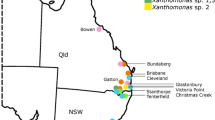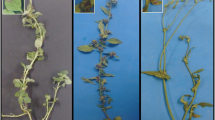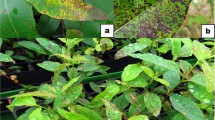Abstract
Plants of Nicandra physaloides, Solanum americanum and Euphorbia heterophylla with leaf lesions have been found naturally grown among tomato plants in commercial fields in Brazil. Tomato bacterial spot was occurring in these fields. Xanthomonad-like isolates were obtained from affected weed leaf samples. These isolates were species identified using BOX-PCR and specific primers. Isolates from N. physaloides and S. americanum were identified as Xanthomonas perforans and that of E. heterophylla were identified as X. gardneri. Each of them was able to artificially infect and cause symptoms on the three weed species and tomato plants.
Similar content being viewed by others
Avoid common mistakes on your manuscript.
Introduction
Tomato bacterial spot can be caused by Xanthomonas euvesicatoria, X. vesicatoria, X. perforans, and X. gardneri (Jones et al. 2004). Surveys on the occurrence of this bacterial complex in tomato have been made in different localities of Brazil and around the world (Quezado-Duval et al. 2005; Kornev et al. 2009; Myung et al. 2009; Hamza et al. 2010; Pereira et al. 2011). However, there are still few reports concerning the role of weeds in the epidemiology of tomato bacterial spot. Some weeds, such as Solanum americanum, Physalis pubescens (Jones et al. 1986) and Nicandra physaloides (Bradbury 1986), have been described, by both naturally and/or artificial inoculation, as survival sources of Xanthomonas campestris pv. vesicatoria, one of the former names used for the bacterial spot causal agent, prior to the reclassification by Jones et al. (2004).
As well as crop residues and volunteer plants, weeds have been considered possible sources of inoculum of pathogens and may be associated with the persistence of Xanthomonas species in the field (Jones et al. 1986; Ignatov et al. 2007). Furthermore, in Brazil, the weed species N. physaloides and S. americanum compete with tomato crops for soil nutrients (Nascente et al. 2004; Hernandez et al. 2007). The aim of this study was to record the occurrence of bacterial spot xanthomonads on sprouting weeds of tomato fields in Brazil.
Materials and methods
Leaf samples were collected with distributed spot lesions on the leaf surface or occasionally necrotic lesions on the leaf edges of N. physaloides and S. americanum in processing tomato crops in the state of Goiás, in central Brazil, and of Euphorbia heterophylla in fresh-market tomato crops in the state of Santa Catarina in the south of the country. As bacterial spot was generally spread among these fields, affected tomato leaf samples were also collected. The pathogens were isolated on Nutrient Agar - NA (Schaad et al. 2001) and proceeded to preservation in phosphate buffer (8.5 mM K2HPO4; 7.5 mM KH2PO4, pH 7.0) at room temperature and on nutrient broth amended with 30 % glycerol at −80 °C. Eight isolates were obtained from the weed species [two of S. americanum (EH 2009-343 and EH 2009-344), two of N. physaloides (EH 2011-39 and EH 2011-41), and four of E. heterophylla (EH 2010-175, EH 2010-176, EH 2010-177, and EH 2010-179)], and three of the tomato samples (EH 2011-61, the same field of those from N. physaloides; EH 2009-250, the same from the S. americanum field, and 2010-53, the same from E. heterophylla). Species reference isolates from Instituto Biológico de São Paulo, Campinas, São Paulo [X. euvesicatoria, IBSBF 2363 (=XVp 197, from USA; X. vesicatoria, IBSBF 2364 (=XV1111, from New Zealand); X. perforans, IBSBF 2370 (=ATCC BAA-983, from USA), and X. gardneri, IBSBF 2373 (=XCGA2, from Yugoslavia)], and isolates representing the four species (EH 2009-46, X. euvesicatoria; EH 2010-41, X. vesicatoria, EH 2008-13; X. perforans, and EH 2010-42, X. gardneri) causing tomato bacterial spot in Brazilian fields from the collection of plant pathogenic bacteria of Embrapa Hortaliças were also used in this study.
The xanthomonad isolates obtained were identified to species by molecular analysis. DNA extraction was performed according to the protocol developed by Mahuku (2004). PCR with specific primers (Koenraadt et al. 2009) was made following the protocol adjusted by Pereira et al. (2011). BOX-PCR (Versalovic et al. 1991) was then carried out according to the protocol established by Costa et al. (2012). A dendrogram was generated by GelCompar II version 6.5 program (Applied Maths) using Dice coefficient and UPGMA method.
For pathogenicity tests, the isolates of each weed host and those xanthomonad species isolates from Brazil (EH 2009-46, EH 2010-41, EH 2008-13, and 2010-42), were inoculated in tomato plants of the susceptible variety ‘Bonny Best’, and in plants of the three weed original host species (three plants to each isolate). Bacterial suspensions were prepared in magnesium sulphate solution (10 mM), and their concentrations were adjusted in spectrophotometer (OD600 = 0.3) to approximately 5 × 108 CFU/ml (Jones et al. 2000). After inoculation by spraying to the runoff point, the plants were maintained in plastic bags for keeping moist chamber for 48 h. The evaluation of the plants was made between 10 and 21 days after inoculation. We repeated the isolation in NA from leaves, which presented spots and/or necrosis to complete Koch’s postulates.
Results and discussion
Bacterial cultures isolated from leaf lesions of weeds in NA medium showed typical colony characteristics (yellow-pigmented and mucoid-rounded shape) of the genus Xanthomonas, both for isolation of field samples and for isolation from the inoculations in the greenhouse.
The isolates from N. physaloides and S. americanum were identified as X. perforans. Isolates from E. heterophylla were characterized as X. gardneri. These isolates amplified a DNA fragment of 197 bp and 154 bp with primer pair Bs-XpF/Bs-XpR and Bs-XgF/Bs-XgR (Koenraadt et al. 2009), respectively (Fig. 1). According to BOX-PCR technique, these isolates clustered together with their respective IBSBF reference species (Fig. 2).
Leaf lesions in weeds observed after artificial inoculation ofXanthomonas species. a –leaf lesions in Euphorbia heterophylla caused by X.perforans (EH 2008-13) 10 days after inoculation; b leaf lesions in Nicandra physaloides caused by X.gardneri (EH 2010-177) 10 days after inoculation; c leaf lesions in Solanum americanum caused by X.euvesicatoria (EH 2009-46) 15 days after inoculation
Amplicons from DNA of Xanthomonas species causing bacterial leaf spot on weeds obtained with species-specific primers. a 1 and 2:X. perforans (EH 2011-39 and EH 2011-41, respectively) from Nicandra physaloideswith primer pair Bs-XpF/Bs-XpR, 3 and 4:X. perforans (EH 2009-343 and EH 2009-344, respectively) from Solanum americanum with primer pair Bs-XpF/Bs-XpR; PC: X. perforans reference isolate IBSBF 2370 (=ATCC BAA-983, from the USA); b 1,2,3 and 4:X. gardneri (EH 2010-175, EH 2010-176, EH 2010-177 and EH 2010-179, respectively) from Euphorbia heterophylla with primer pair Bs-XgF/Bs-XgR, PC: X. gardneri reference isolate IBSBF 2373 (=XCGA2, from Yugoslavia); NC Negative control, M Molecular marker (100 bp DNA Ladder, Invitrogen)
Regarding the genomic profiles generated by BOX-PCR, the isolates of X. gardneri from weeds and from the same area had similarity ranging from 80.4 to 85.7 % (Fig. 2). The similarity between these isolates and the isolate from tomato was 85.7 %. The minimal similarity showed between all X. gardneri isolates and reference IBSBF 2373 was 70.2 %. It is worth noting that the leaf samples of E. heterophylla originated from a producing fresh-market tomato region where X. gardneri has been present causing bacterial spot (Costa et al. 2012). This prevalence was possibly associated with better adaptation of X. gardneri to lower temperatures (Araújo et al. 2011), characteristic of the Brazilian south region. On the other hand, isolates of X. perforans were more diverse among each other, with similarity of 75.3 to 75.7 %. Whether or not the diversity observed for both species would reflect the overall variation of the species is still to be addressed. From the first report on the occurrence of X. perforans in Brazil, low polymorphism was found in this species, together with X. vesicatoria and X. gardneri, and was hypothetically attributed to be related to recent introduction events (Quezado-Duval et al. 2005). In the present study, X. perforans isolates came from processing tomato crops in Brazil, characterized by frequent occurrences of bacterial spot (Quezado-Duval and Lopes 2010). These frequent occurrences, nevertheless, can be associated with the maintenance of the bacterial spot pathogen(s) in the area from one crop season to another in volunteer plants (Quezado-Duval and Lopes 2010).
Xanthomonas euvesicatoria (IBSBF 2363) showed similarity of up to 82.2 % with some isolates of X. perforans, making the grouping of all isolates of the species with the reference isolate difficult. In fact, until recently, X. perforans was treated as a subgroup of X. euvesicatoria before reclassification proposed by Jones et al. (2004). However, some authors have shown that these species can be difficult to distinguish by techniques such as BOX-PCR (Costa et al. 2012) and multilocus sequence analysis using four genes: dnaK, fyuA, gyrB and rpoD (Young et al. 2008). Thus, for differentiation between these species, more than one molecular technique should be employed in addition to traditional biochemical and pathogenicity tests. However, the problem has been overcome with the use of specific primers designed by Koenraadt et al. (2009) and validated for Brazilian isolates by Araújo et al. (2012) for all the species associated with tomato bacterial spot so far.
All isolates from the weeds were able to cause symptoms in tomato plants and in the plants of their respective original host weeds (Table 1, Fig. 3). Tomato plants had leaf lesions from 5 to 7 days after inoculation, always before the development of the symptoms on the weeds evaluated. In N. physaloides and E. heterophylla, the first leaf spots appeared about 10 days after inoculation, whereas in S. americanum, the first leaf lesions were observed only 15 days after inoculation (Fig. 3). This period of time was similar to that found by Jones et al. (1986) when Xanthomonas campestris pv. vesicatoria was inoculated on this host in field trials. Some quantitative resistance level might contribute to a longer incubation period, observed especially on S. americanum, and could also be related to a lack of full adaptation of the X. perforans and X. gardneri to these hosts. The fact that, for the all four weed species, no symptoms were observed before nine days after inoculation, indicates a susceptibility reaction of the weeds, and not a hypersensitivity one, which is characterized by a quick appearance of lesions after inoculation (Klement and Goodman 1967). Unlike as for X. perforans and X. gardneri, the pathogenicity of the other xanthomonads of the bacterial spot complex was variable. Xanthomonas euvesicatoria (EH 2009-46) was not pathogenic to E. heterophylla, whereas X. vesicatoria (EH 2010-41) was able to cause leaf lesions only in this host and was not pathogenic to N. physaloides and S. americanum.
Dendrogram generated from the comparison of genomic profiles obtained by BOX-PCR from 15 isolates of Xanthomonas from weeds and tomato and reference isolates IBSBF. Cluster analysis was performed by UPGMA and Dice coefficient used for calculating similarity. W = isolates from weeds; T = isolates from tomato; Xe = X. euvesicatoria; Xv = X. vesicatoria; Xp = X. perforans; Xg = X. gardneri
According to Jones et al. (1986), weeds would be inoculum sources with reduced epidemiological importance due to the delay in the appearance of the first lesions, usually greater than 10 days, as observed in the present study. However, to better understand the epidemiological importance of the weeds for the bacterial spot epidemics in Brazilian processing tomato fields, further studies on the population growth, weed seed infection, and efficiency of transmission from symptomatic weeds to tomato plants in the fields should be carried out. Thus, in accordance to the Sigee concept of plant disease derived from a bacterial infection (Sigee 1993), this is the first report of X. perforans and X. gardneri naturally causing apparent and reproducible foliar deterioration, on N. physaloides and E. heterophylla, respectively.
References
Araújo, E. R., Pereira, R. C., Ferreira, M. A. S. V., Café Filho, A. C., Moita, A. W., & Quezado-Duval, A. M. (2011). Effect of temperature on pathogenicity components of tomato bacterial spot and competition between Xanthomonas perforans and X. gardneri. Acta Horticulturae, 914, 39–42.
Araújo, E. R., Costa, J. R., Ferreira, M. A. S. V., & Quezado-Duval, A. M. (2012). Simultaneous detection and identification of the Xanthomonas species complex associated with tomato bacterial spot using species-specific primers and multiplex PCR. Journal of Applied Microbiology, 113, 1479–1490.
Bradbury, J. F. (1986). Guide to plant pathogenic bacteria (p. 244). England: CAB International Mycological Institute.
Costa, J. R., Araújo, E. R., Becker, W. F., Ferreira, M. A. S. V., & Quezado-Duval, A. M. (2012). Ocorrência e caracterização do complexo de espécies causadoras da mancha bacteriana do tomateiro no Alto Vale do Rio do Peixe, SC. Tropical Plant Pathology, 37, 149–154.
Hamza, A. A., Robène-Soustrade, I., Jouen, E., Gagnevin, L., Lefeuvre, P., Chiroleu, F., & Pruvost, O. (2010). Genetic and pathological diversity among Xanthomonas strains responsible for bacterial spot on tomato and pepper in the southwest Indian Ocean region. Plant Disease, 94, 993–999.
Hernandez, D. D., Alves, P. L. C. A., Pavani, M. C. M. D., & Parreira, M. C. (2007). Períodos de interferência de maria-pretinha sobre tomateiro industrial. Horticultura Brasileira, 25, 199–204.
Ignatov, A., Sechler, A., Schuenzel, E. L., Agarkova, I., Oliver, B., Vidaver, A. K., & Schaad, N. W. (2007). Genetic diversity in populations of Xanthomonas campestrispv. campestris in cruciferous weeds in central coastal California. Phytopathology, 97, 803–812.
Jones, J. B., Pohronezny, K. L., Stall, R. E., & Jones, J. P. (1986). Survival of Xanthomonas campestris pv. vesicatoria in Florida on tomato crop residue, weeds, seeds, and volunteer tomato plants. Phytopathology, 76, 430–434.
Jones, J. B., Bouzar, H., Stall, R. E., Almira, E. C., Roberts, P. D., Bowen, B. W., Sudberry, J., Strickler, P. M., & Chun, J. (2000). Systematic analysis of xanthomonads (Xanthomonas spp.) associated with pepper and tomato lesions. International Journal of Systematic and Evolutionary Microbiology, 50, 1211–1219.
Jones, J. B., Lacy, G. H., Bouzar, H., Stall, R. E., & Schaad, N. W. (2004). Reclassification of the xanthomonads associated with bacterial spot disease of tomato and pepper. Systematic and Applied Microbiology, 27, 755–762.
Klement, Z., & Goodman, R. N. (1967). The hypersensitive reaction to infection by bacterial plant pathogens. Annual Review of Phytopathology, 5, 17–44.
Koenraadt, H., van Betteray, B., Germain, R., Hiddink, G., Jones, J. B., Oosterhof, J., Rijlaarsdam, A., Roorda, P., & Wouldt, B. (2009). Development of specific primers for the molecular detection of bacterial spot of pepper and tomato. Acta Horticulturae, 808, 99–102.
Kornev, K. P., Matveeva, E. V., Pekhtereva, E. S. H., Polityko, V. A., Ignatov, A. N., Punina, N. V., & Schaad, N. W. (2009). Xanthomonas species causing bacterial spot of tomato in the Russian Federation. Acta Horticulturae, 808, 243–246.
Mahuku, G. S. (2004). A simple extraction method suitable for PCR-based analysis of plant, fungal, and bacterial DNA. Plant Molecular Biology Reporter, 22, 71–81.
Myung, I.-S., Moon, S. Y., Jeong, I. H., Lee, Y.-K., Lee, Y.-H., & Ra, D. S. (2009). Bacterial spot of tomato caused by Xanthomonas perforans, a new disease in Korea. Plant Disease, 93, 1349.
Nascente, A. S., Pereira, W., & Medeiros, M. A. (2004). Interferência das plantas daninhas na cultura do tomate para processamento. Horticultura Brasileira, 22, 602–606.
Pereira, R. C., Araújo, E. R., Ferreira, M. A. S. V., & Quezado-Duval, A. M. (2011). Occurrence of Xanthomonas species causing bacterial spot in fresh market tomato fields in Brazil. Acta Horticulturae, 914, 61–64.
Quezado-Duval, A. M., & Lopes, C. A. (2010). Mancha bacteriana: uma atualização para o sistema de produção integrada de tomate indústria. 28 p. Brasília: Embrapa Hortaliças, (Circular Técnica 84).
Quezado-Duval, A. M., Leite Júnior, R. P., Lopes, C. A., Lima, M. F., & Camargo, L. E. A. (2005). Diversity of Xanthomonas spp. associated with bacterial spot of processing tomatoes in Brazil. Acta Horticulturae, 695, 101–108.
Schaad, N. W., Jones, J. B., & Chun, W. (2001). Laboratory guide for identification of plant pathogenic bacteria. St Paul: American Phytopathological Society Press.
Sigee, D. C. (1993). Bacterial plant pathology. Cambridge: Cambridge University Press.
Versalovic, J., Koeuth, T., & Lupski, J. R. (1991). Distribution of repetitive DNA sequences in eubacteria and application to fingerprinting of bacterial genomes. Nucleic Acids Research, 19, 6823–6831.
Young, J. M., Park, D.-C., Shearman, H. M., & Fargier, E. (2008). A multilocus sequence analysis of the genus Xanthomonas. Systematic and Applied Microbiology, 31, 366–377.
Acknowledgments
We acknowledge The Foundation for Research Support of the State of Goiás and Embrapa for financial support (grant n° 005/2012 and project 02120101100, respectively).
Author information
Authors and Affiliations
Corresponding author
Rights and permissions
About this article
Cite this article
Araújo, E.R., Costa, J.R., Pontes, N.C. et al. Xanthomonas perforans and X. gardneri associated with bacterial leaf spot on weeds in Brazilian tomato fields. Eur J Plant Pathol 143, 543–548 (2015). https://doi.org/10.1007/s10658-015-0705-9
Accepted:
Published:
Issue Date:
DOI: https://doi.org/10.1007/s10658-015-0705-9







